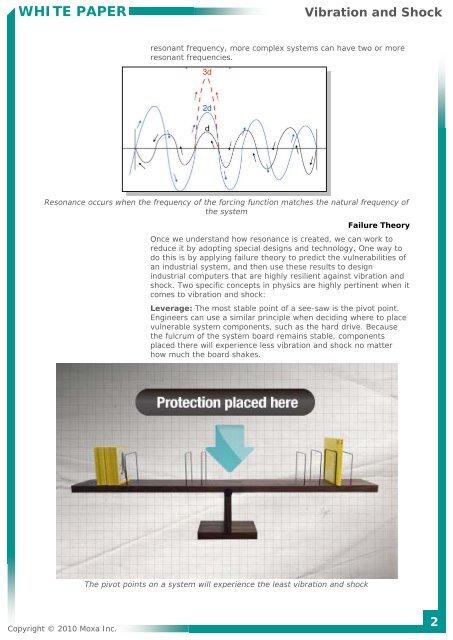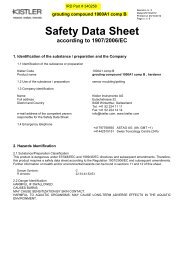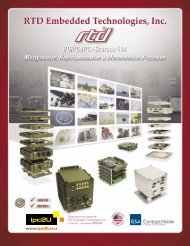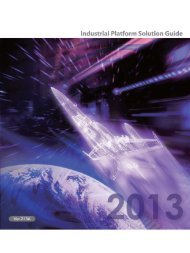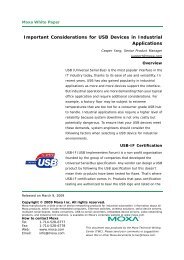WHITE PAPER<strong>Vibration</strong> <strong>and</strong> <strong>Shock</strong><strong>Industrial</strong> computersneed <strong>to</strong> be designed <strong>to</strong>withst<strong>and</strong> vibration <strong>and</strong>shock, which are a fac<strong>to</strong>f life in many industrialapplications.Systems should avoidresonance, which allowseven small forces <strong>to</strong>create extreme vibration<strong>and</strong> shock.<strong>Industrial</strong> computer manufacturers need <strong>to</strong> deliver a product <strong>that</strong>is rugged, hardened, <strong>and</strong> reliable <strong>to</strong> a degree beyond the consumerst<strong>and</strong>ard. These requirements exist because industrial computersare often deployed in severe conditions <strong>and</strong> harsh environments,sometimes even on moving vehicles. One key industrialrequirement is vibration <strong>and</strong> shock resistance, which allowsindustrial computers <strong>to</strong> operate in truly extreme conditions.There are some industrial applications, such as rolling s<strong>to</strong>ck, wherevibration <strong>and</strong> shock are the most significant fac<strong>to</strong>r affecting thestability <strong>and</strong> reliability of system operations. <strong>Computers</strong> in rollings<strong>to</strong>ck applications are deployed on moving objects <strong>that</strong> rattle <strong>and</strong>shake, so anti-vibration <strong>and</strong> anti-shock technology is a centralrequirement. Certain rolling s<strong>to</strong>ck applications, such as NetworkVideo Recording (NVR) systems, specifically need high s<strong>to</strong>ragecapacity <strong>to</strong> record <strong>and</strong> s<strong>to</strong>re surveillance video images. Hard diskswould be the most reasonable <strong>and</strong> cost-effective way <strong>to</strong> s<strong>to</strong>re all ofthis data, but deploying hard disks in a high-vibration high-shockenvironment, such as on a bus, train, or truck, is a significantchallenge.This white paper first explains some background about the physicsbehind vibration <strong>and</strong> shock, <strong>and</strong> then explores the specificmechanisms <strong>and</strong> technology used <strong>to</strong> build an industrial computerwith high resilience against vibration <strong>and</strong> shock.About <strong>Vibration</strong>Physically, there are two kinds of vibrations: free vibration <strong>and</strong>forced vibration. Free vibration occurs when a mechanical systemis acted on by an initial input <strong>and</strong> then allowed <strong>to</strong> vibrate freely.Forced vibration occurs when an oscillating force or motion isapplied <strong>to</strong> a mechanical system.About ResonanceIn physics, “resonance” describes how a system can oscillate atlarge amplitudes at specific, "resonant" frequencies. An importantpoint <strong>that</strong> all engineers must keep in mind is <strong>that</strong> a low amplitudeforce acting at the system's resonant frequency can createextremely large displacements.Resonance occurs in systems <strong>that</strong> can convert back <strong>and</strong> forthbetween s<strong>to</strong>red (or potential) energy <strong>and</strong> kinetic energy. Theclassic example of a resonant system is a pendulum, whichalternates between states of high-kinetic <strong>and</strong> low-potential energy(when the pendulum moves through the vertical position at thebot<strong>to</strong>m of its swing) <strong>and</strong> low-kinetic <strong>and</strong> high-potential energy(when the pendulum slows down <strong>and</strong> then reverses direction). Thependulum will swing at its resonant frequency if the only externalforce is gravity. Although a simple pendulum has only oneReleased on Oc<strong>to</strong>ber 1, 2010Copyright © 2010 Moxa Inc., all rights reserved.Moxa manufactures one of the world’s leading br<strong>and</strong>s of device networking solutions. Products include industrialembedded computers, industrial Ethernet switches, serial device servers, multiport serial boards, embedded deviceservers, <strong>and</strong> remote I/O solutions. Our products are key components of many networking applications, includingindustrial au<strong>to</strong>mation, manufacturing, POS, <strong>and</strong> medical treatment facilities.<strong>How</strong> <strong>to</strong> contact MoxaTel: 1-714-528-6777Fax: 1-714-528-6778Web: www.moxa.comEmail: info@moxa.comThis document was produced by the Moxa Technical WritingCenter (TWC). Please send your comments or suggestions aboutthis or other Moxa documents <strong>to</strong> twc@moxa.com.Copyright © 2010 Moxa Inc.1
WHITE PAPER<strong>Vibration</strong> <strong>and</strong> <strong>Shock</strong>resonant frequency, more complex systems can have two or moreresonant frequencies.Resonance occurs when the frequency of the forcing function matches the natural frequency ofthe systemFailure TheoryOnce we underst<strong>and</strong> how resonance is created, we can work <strong>to</strong>reduce it by adopting special designs <strong>and</strong> technology. One way <strong>to</strong>do this is by applying failure theory <strong>to</strong> predict the vulnerabilities ofan industrial system, <strong>and</strong> then use these results <strong>to</strong> designindustrial computers <strong>that</strong> are highly resilient against vibration <strong>and</strong>shock. Two specific concepts in physics are highly pertinent when itcomes <strong>to</strong> vibration <strong>and</strong> shock:Leverage: The most stable point of a see-saw is the pivot point.Engineers can use a similar principle when deciding where <strong>to</strong> placevulnerable system components, such as the hard drive. Becausethe fulcrum of the system board remains stable, componentsplaced there will experience less vibration <strong>and</strong> shock no matterhow much the board shakes.The pivot points on a system will experience the least vibration <strong>and</strong> shockCopyright © 2010 Moxa Inc.2


